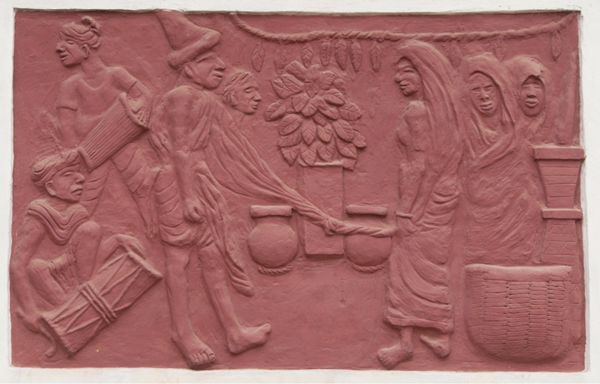
Marriage Reception
A Santal marriage takes five days and involves various, often complex, rituals. On the day of the Gidi-chumara (Marriage Reception) the women arrive to bless the bride and groom with grass and grains of rice which are kept in a basket. The high wooden turmeric crusher called akhur (on the right) indicates that tumeric powder is used to soak the wedding dress in turmeric water to clean it and purify it ritually. The clothes of bride and groom are being tied together as a sign of their oneness.
The centre of the courtyard where some of the marriage rituals take place is called Mandwa. There, a branch of the Mahua, the blackberry, the mango or the Sal tree is planted. It is believed that benevolent spirits dwell in these trees. Two earthen pots are placed on either side of the branch. These pots are filled with water and carried along by two unmarried girls of the village. They are meant to remind the bride of her friendship with the village people. A man is playing the marriage drum, behind him is a man with an ordinary drum.
Source: Santals Celebrate the Seasons published by Ashadullapur Gramin Silpa & Sastha Bidhan Kendra and Ghosaldanga Bishnubati Adibasi Trust © 2014
Learn more about this unique project, view the entire series of photographs or download the eBook here: Six Murals by Sanyasi Lohar and his team >
All contents are being published with an understanding that the respective copyright owners have agreed to the license terms explained in the Creative Commons Attribution-NonCommercial-NoDerivs 3.0 Unported License. This means that no commercial use or modification of such content is permissible without written consent by their respective copyright holders.
Santal marriage known as ‘Hor bapla’ in Santali is the most complex social and religious ceremony of the Santals. It begins in the month of Falgun and continues upto Josthi (March to June). Marriage for Santals is not only the communion of two individuals but also the occasion to strengthen the kinship relationship of two families and their villagers. Following are some forms of marriages practiced in Santal parganas, northern part of West Bengal, Assam, Nepal and Bangladesh with little changes according to the practices of the villages. | Learn more >>
Source: “Towa Dare – O my beloved mother II Marriage song”
URL: https://www.youtube.com/watch?v=RnAWF6TKIWs
Date Visited: 25 September 2022
Learn more
Ashadullapur Gramin Silpa & Sastha Bidhan Kendra | Sanyasi Lohar
Crafts and visual arts | Masks
Daricha Foundation | Deoal Chitro (wall paintings) | Homepage | YouTube channel
eBook | Background guide for education
Ghosaldanga Bishnubati Adibasi Trust
Santal music CD and DVD by Ghosaldanga Bishnubati Adibasi Trust
Santali language | eBook | A Santali-English dictionary – Archive.org
Video | Roots and Branches: The Lifeworld of an Enlightened Villager in West Bengal
Video | Santali video album “Ale Ato” (Our Village, Part 1 of 2) – West Bengal
To locate the Museum of Santal Culture in Bishnubati village (near Santiniketan) on the map seen below, open by clicking on the left button:
Tips for using interactive maps
Toggle to normal view (from reader view) should the interactive map not be displayed by your tablet, smartphone or pc browser
For details and hyperlinks click on the rectangular button (left on the map’s header)
Scroll and click on one of the markers for information of special interest
Explore India’s tribal cultural heritage with the help of another interactive map >>
